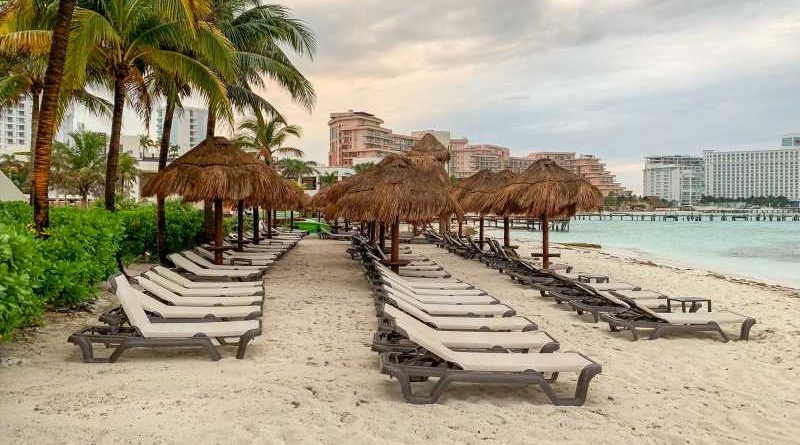Mexico’s ‘stoplight system’ explained: What a Cancun lockdown would mean for your trip
Load Error
As several destinations reopen after the COVID-19 shutdowns, one location that’s highly popular with American travelers could be heading in the opposite direction toward a shutdown.
Quintana Roo, the Mexican state on the Caribbean coast, is home to iconic resort getaways such as Cancun and Tulum. But the state’s governor said last week that the popular destination has seen five weeks of increases in COVID-19 cases. Now, the state is at risk of imposing an “immediate lockdown.”
The Mexican government uses a so-called stoplight system, which is frequently updated, to determine what is allowed to open or must remain closed in its states. While bars and clubs may be open in one state, those activities may be prohibited entirely in another. And these restrictions apply not just to Mexican citizens, but also to tourists.
Here’s what you need to know if Quintana Roo goes into a red designation.
For more TPG news, deals and points and miles tips delivered each morning to your inbox, subscribe to our daily newsletter.
Mexico’s stoplight system
The four metrics to assess the colors (green, yellow, orange and red) are the trend in numbers of new cases, hospital occupancy trends, current hospital occupancy rates and percentage of positive cases. Here’s what you need to know about each designation.
Green
Under the “green” designation, all activities are allowed with no restrictions. Fourteen Mexican states are currently in the “green” designation.
Yellow
Under the “yellow” designation, some public spaces are open, but closed public spaces are operating at reduced capacity. Fifteen states, including Mexico City, are considered “yellow.” Hotels and restaurants can operate at 75% occupancy, while museums and theaters can operate at 50%.
Orange
There are quite a few more restrictions under the “orange” designation.
Under “orange,” nonessential companies are allowed to work with 30% of their personnel. Open public spaces will operate with a reduced capacity, but closed spaces will be completely shut down. Hotels and restaurants can operate at 50% capacity, while theaters and shopping centers are capped at 25%. Large events, as well as nightclubs and bars, are supposed to be shut down.
Three states are in the “orange” designation. That includes Quintana Roo — which could soon go into “red.” Already, Cancun’s city council has shut down several busy streets from 11 p.m. to 1 a.m. to avoid going into “red.”
Red
Currently, none of Mexico’s 32 states are in the “red” designation. Under “red,” the strictest designation, hotels can operate at 25% capacity, but congregating in common areas is not allowed. Only room service or delivery service is permitted.
Public spaces can operate at 25% capacity, but bars, nightclubs, theaters and museums are closed. Sporting events can still take place, but without spectators. Only essential activities are permitted. People are allowed to go for a walk outside around their homes during the day.
What does Mexico’s stoplight system mean for your travel plans?
Travelers headed to Cancun, Playa del Carmen or Tulum, among other destinations in Quintana Roo, now are under several social distancing restrictions under the “orange” designation.
Bars, nightclubs and other entertainment venues are supposed to be closed at this time, according to the state government, but several readers noted packed bars during their recent trips.
But there are several more restrictions under “red.” There are numerous reports that under the “red” designation, hotels would only be open to essential workers at 25% occupancy, however, we couldn’t confirm or deny this in time for publication.
A spokesperson for the Quintana Roo Tourism Board sent a statement to TPG, saying that collaboration between the public and private sector has been “critical” to reopening the Quintana Roo region.
So, while you would still be able to visit Quintana Roo (or any other destination in Mexico) if it goes to “red,” you might not be able to do much. So, you may want to change or cancel your flight or hotel reservation — and, depending on your reservation, you may be able to do so easily.
Many hotels and airlines adopted flexible change and cancellation policies during the pandemic, such as waiving change fees for new travel booked by a certain date.
“If there are no travel restrictions, we would keep our 24-hour cancellation policy as we have since our reopening in June,” Peter Hechler, the general manager at the Banyan Tree Mayakoba in Playa del Carmen, said in an emailed statement. “If guests purchased a nonrefundable rate, we would offer to change their stay dates to a more convenient time to travel.”
Many U.S. and foreign carriers fly between the U.S. and Cancun (CUN) daily, with a smaller number flying to nearby Cozumel. Make sure to check what kind of ticket you’ve booked, however, because basic economy fares may not be covered. Some carriers will also allow customers to change their origin and destination cities, but a difference in fare may apply. If you booked an award ticket, several airlines will allow you to change or redeposit award tickets without penalty.
Still, after more than a year of COVID-19 health and financial woes, many members of the travel industry aren’t ready for another wave of lockdowns.
“The staff here at Banyan Tree Mayakoba has been diligent in the correct handling of preventive safety measures,” Hechler said. “We trust that the state knows the importance of tourism and prioritizes their and our own safety. We hope that these messages are cautionary warnings.”
Bottom line
While you would still be able to visit Cancun if Quintana Roo goes “red,” the experience might be significantly scaled-down. That means some of the activities planned before you get there, like bar-crawling or sporting events, wouldn’t be possible.
Movement around your hotel might also be restricted. If that doesn’t sound like a good time, you may want to look closely at your travel bookings to change or cancel if you need to.
Featured photo by Zach Griff/The Points Guy
SPONSORED: With states reopening, enjoying a meal from a restaurant no longer just means curbside pickup.
And when you do spend on dining, you should use a credit card that will maximize your rewards and potentially even score special discounts. Thanks to temporary card bonuses and changes due to coronavirus, you may even be able to score a meal at your favorite restaurant for free.
These are the best credit cards for dining out, taking out, and ordering in to maximize every meal purchase.
—
Editorial Disclaimer: Opinions expressed here are the author’s alone, not those of any bank, credit card issuer, airlines or hotel chain, and have not been reviewed, approved or otherwise endorsed by any of these entities.
Source: Read Full Article




